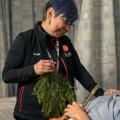Heart monitors
Learn more about our heart monitors and how to access them.
Overview
Heart and blood pressure monitors allow you to record your blood pressure and your heart’s activity as you go about your usual day. These monitors can cover a much longer period of time than is possible in your doctor’s office. It provides your care team with more complete information.
There are different kinds of monitors. They include:
- an ambulatory blood pressure monitor, and
- a Holter monitor (24h or 48h)
St. Paul’s Hospital loans these devices to patients for the duration of the test. These tests are performed by a Registered Cardiology Technologist or an ECG Assistant. They will help you with these devices.
Preparing for the test
Ambulatory Blood Pressure Monitor (ABPM)
The purpose of this test is to check your blood pressure over time.
- Allow one hour to put on the monitor. You will need to return to the Cardiology Lab the following day to drop it off.
- Wear a loose, short-sleeved shirt for easy access to your arm.
Note: this test is not covered by MSP. There will be a $65 charge for this test.
Payment instructions:
- Before your appointment, go to the Cashier’s Office to make the payment.
- Bring the invoice provided by the Cardiology Lab and give it to the Cashier’s office. They will accept cash or credit card.
- Please allow 30 minutes for processing.
- Bring the printed receipt and invoice copy to the Cardiology lab for your appointment.
Holter monitor
Holter monitoring is usually used to diagnose heart rhythm issues. It is specifically used to find the cause of palpitations or dizziness. We offer 24 and 28 hour monitoring.
- Have a bath or shower the morning of the test
- Do not put any lotion or powder on your skin
- Wear a loose-fitting blouse or shirt that buttons down the front
- Women should wear a regular or stretchy bra. You should not wear tight-fitting sports bras, long-line bras, or full slips.
- Please bring photo identification and your BC Services Card.
Note: St. Paul’s Hospital and the Heart Rhythm Clinic on Davie Street conduct this test. Be sure you know which location you’ve been referred to.
On the day of the test
Holter monitor
It takes 15-30 minutes to attach the monitor, but please allow one hour in total, for registration and getting changed.
Your care team will attach several sticky patches (electrodes) across your chest. Before attaching the patches, we will clean your skin, if necessary, shave or clip the hair so they stick well. The electrodes will be connected to the Holter monitor which is about the size of a deck of cards and is very light. We will put it in a small pouch that you’ll wear with a belt around your waist or a strap over your shoulder. You can wear normal loose clothes over the monitor so no one will know that you are wearing it. You will wear it for 24 or 48 hours.
During the test
Ambulatory Blood Pressure Monitor (ABPM)
- A blood pressure cuff will be attached to your arm.
- You will wear the device for 24 hours. During that time, you will do your normal activities. In the diary we give you, you will record your activities, as well as any symptoms you may have.
- The cuff will inflate at set intervals through the day and night
Holter monitor
During this test, you will wear a small recording device, called a Holter monitor. Your care team will place small metal disks, called electrodes, on your chest. The electrodes connect to the monitor. A tape records your heart's rhythm and then it's played back into a computer. Your team can review it to find out what is causing your arrhythmia.
For the 24 to 48 hours, do your normal activities. Record any symptoms in a diary (such as shortness of breath, irregular heartbeats, chest discomfort, throat discomfort, jaw discomfort, arm discomfort, or anything else unusual that you feel). Also, record what you were doing (e.g. running, walking, eating, having a bowel movement). While the monitor is on it’s important not to adjust the recorder, sensors, cables or tapes. You also must not shower, bathe or swim.
After the test
Holter monitor
The cardiologist will review the recordings and send a report to your doctor. Where the electrodes were placed, some people may develop a slight rash.
Support for Indigenous Peoples
The Indigenous Wellness Liaison Team is here to support your health journey. Team members offer cultural support and healthcare advocacy. Learn more below or call them at 604-682-2344,62937 or email IWL@providencehealth.bc.ca.
Education & resources
Location
Cardiology Department
Room 2450, Providence Wing, St. Paul’s Hospital
Follow the red line on the floor from the Burrard main entrance all the way to the end.
Transportation & parking
Remember to allow time before your heart monitor test to get from your car or transit to the test area in the Cardiology Department. When you arrive at St. Paul’s Hospital, enter through the main doors off Burrard Street. If you are not sure where to go, ask a volunteer or the Information Desk for directions to the Cardiology Department. Tell them you’re here for a heart monitor test.
Hours
Monday to Friday
8:00 a.m. — 4:00 p.m.
